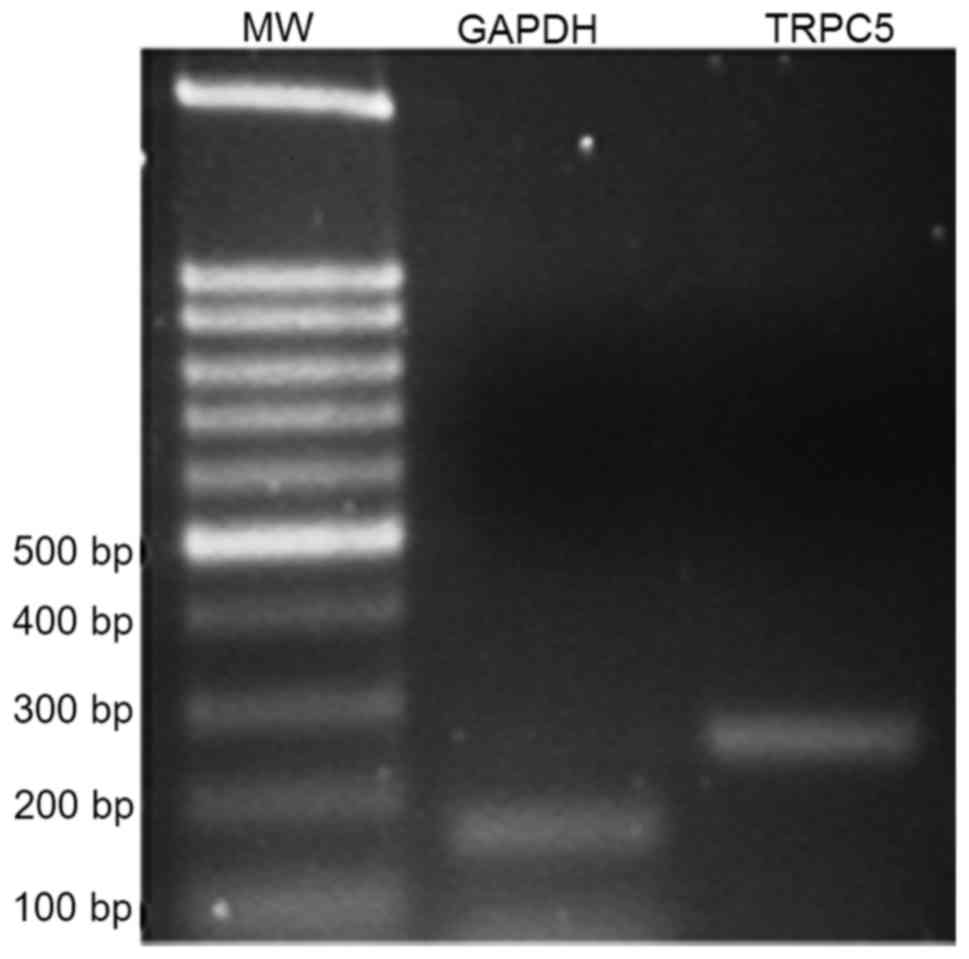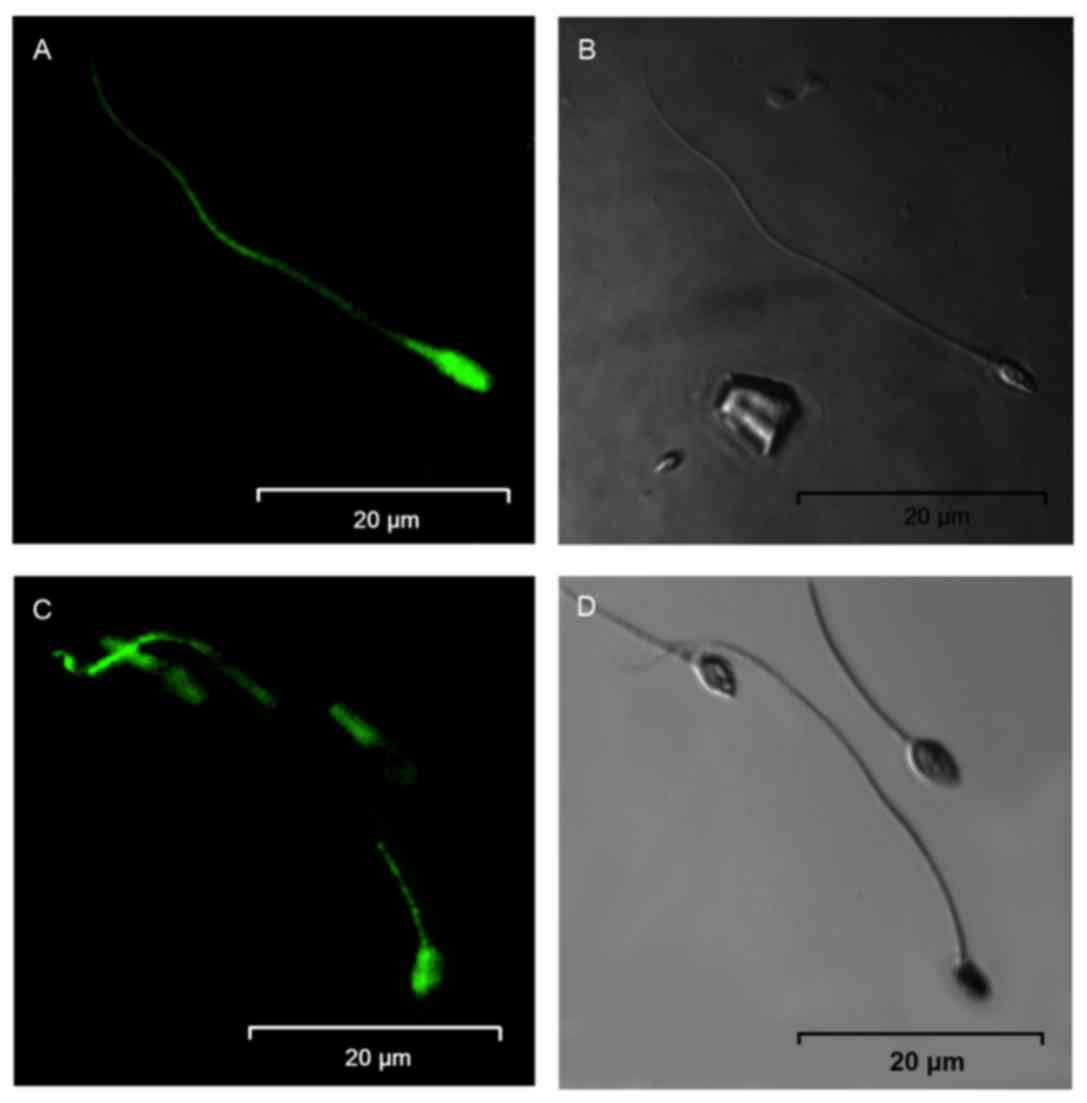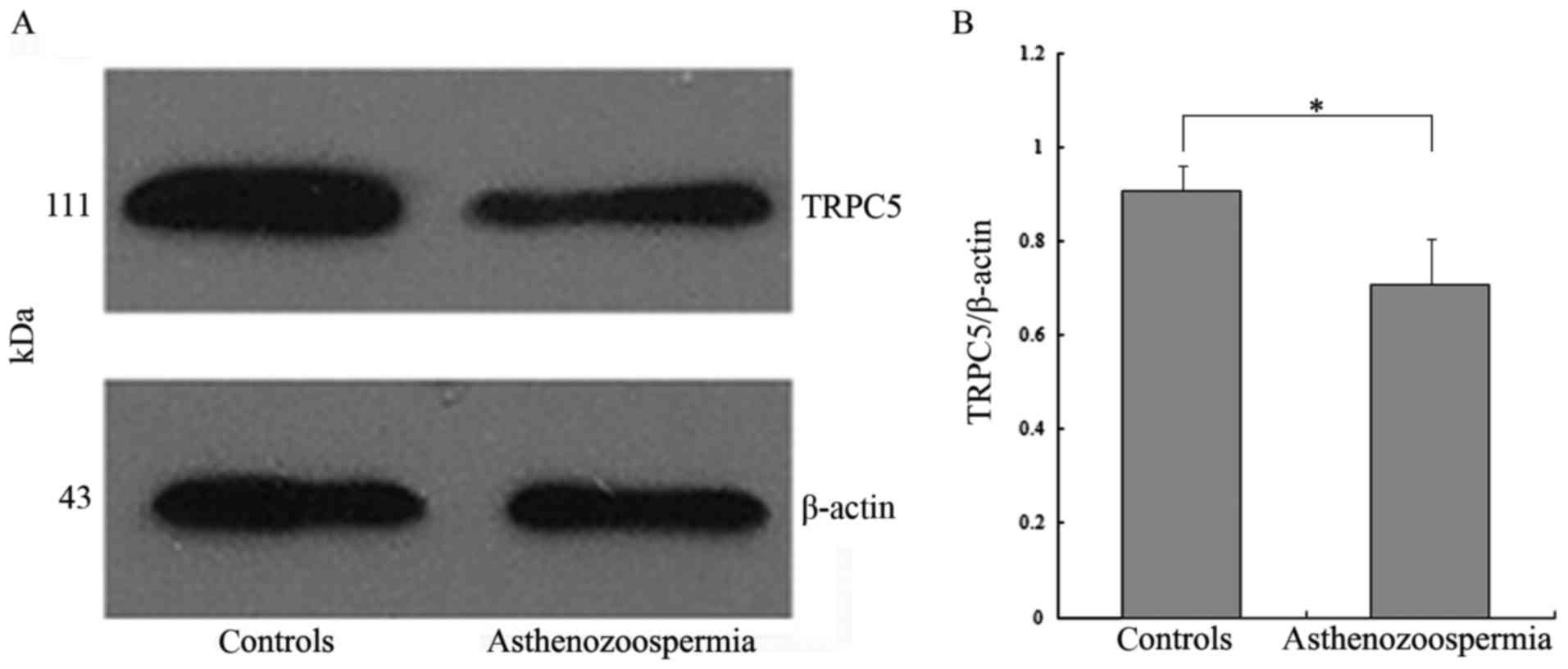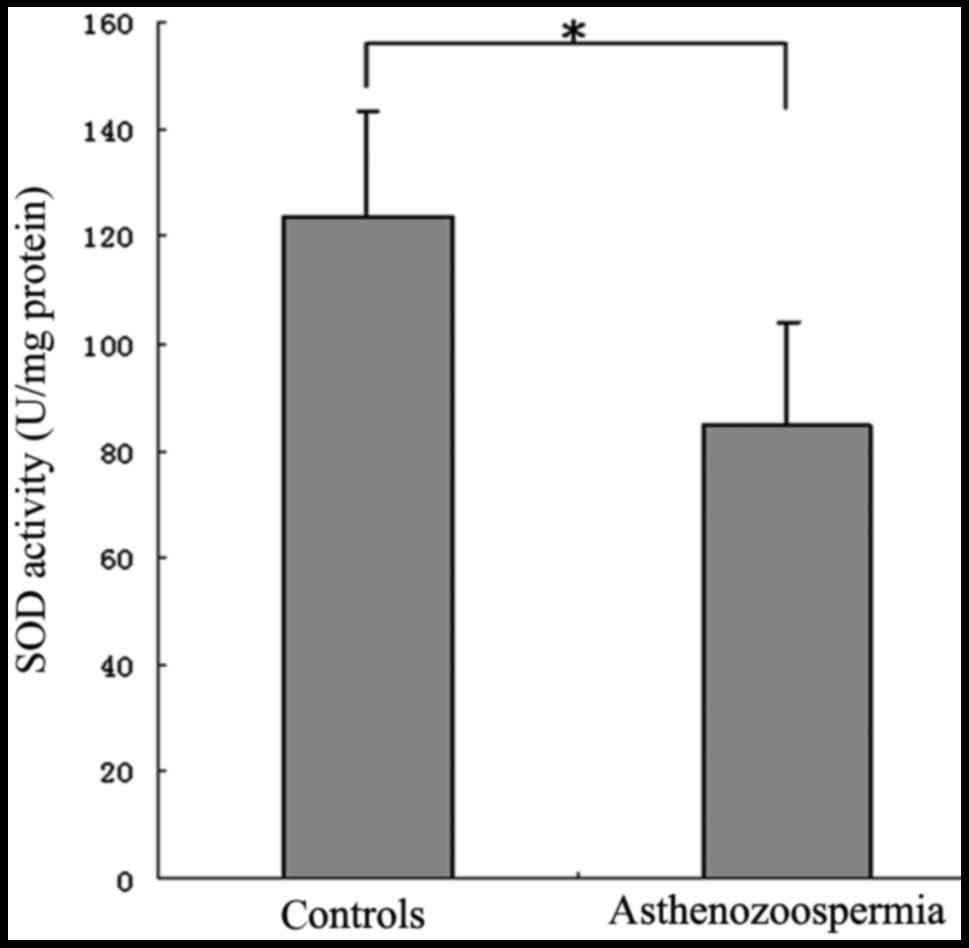Introduction
Fertilization is the phenomenon in which sperm and
egg locate each other, interact and fuse. This phenomenon is
essential for all plants and animals that engage in sexual
reproduction. A previous study on mammalian sperm indicated that an
increase in the concentration of intracellular Ca2+
[(Ca2+)i] was critical for several
physiological processes during fertilization, including sperm
motility, capacitation, and acrosome reaction (AR) (1). Furthermore, calcium has been
demonstrated to serve roles in initiation of motility, capacitation
and AR in spermatozoa, as reviewed by Kumar and Shoeb (2).
A number of calcium channels including homologues of
the Drosophila transient receptor potential (TRP) proteins
have been identified in sperm (3).
TRP channels are a superfamily of functionally versatile cation
permeation channels that are present in most mammalian cell types.
As molecular sensors of the external environment, the TRP ion
channels may serve an important role in sperm maturation and
development of fertilization potential (4,5).
Initially proposed as store-operated calcium
channels in mammals, products of the seven TRPC genes (TRPC1-7)
have been identified based on sequence similarities to TRP
(6,7),
and have been implicated in an increasing range of physiological
processes (8–10). These Ca2+ entry pathways
are also present in mammalian sperm and control the initial stages
of fertilization (11). Although the
function of the different TRPC channels in the sperm flagellum is
unknown, it has been speculated that they may participate in key
events required for fertilization, such as the initiation of
motility (activation) and hyperactivation (12).
In a previous study, Castellano et al
(13) first detected TRPC1, 3, 4, 6
and 7 in human sperm and indicated that these
Ca2+-permeable channels may influence flagellar
movement; however, because of the lack of specific antibody, they
could not detect the TRPC5 channel. Nevertheless, the association
between sperm TRPC channels and human male infertility is unknown
at present.
Infertility is commonly defined as the failure of
conception after ≥12 months of unprotected intercourse (14). Statistics indicate that approximately
15% of all couples in the United States are infertile, and that the
male factor is responsible for ~25% of these cases (15,16).
Varicocele is the most frequent abnormal physical finding in men
who present for infertility evaluation, and represents the most
common treatable cause of male factor infertility (17). Varicocele is associated with
impairment in spermatogenesis in the form of asthenozoospermia,
which is defined by the proportion of motile spermatozoa in semen
(grade a+b sperm motility, <50%; or grade a, <25%) according
to the 2010 World Health Organization laboratory manual for the
examination and processing of human semen (18).
As the expression of sperm TRPCs channels is
involved in the regulation of flagellar motility in human sperm,
the present study investigated the expression of TRPC channels in
spermatozoa from infertile men, which, to the best of our
knowledge, has not been reported to date. For this purpose, the
expression of TRPC5 from ejaculated spermatozoa was compared
between patients with varicocele-associated asthenozoospermia and
age-matched control subjects.
Materials and methods
Ejaculates
The study population consisted of 40 patients with
varicocele-associated asthenozoospermia and 40 age-matched control
healthy subjects with normal semen parameters from the Department
of Andrology of Zhongnan Hospital, Wuhan University (Wuhan, China).
The demographic characteristics of subjects in each group are
listed in Table I. Seminal samples
were obtained by masturbation after 3–5 days of sexual abstinence.
Patients with pyospermia were excluded. It was not assessed whether
patients had experienced a recent fever or toxicant exposure or
were smokers. Informed consent was obtained from subjects
permitting the use of their samples and data for the current study
purposes. The study protocol was approved by the Ethics Committee
of Zhongnan Hospital of Wuhan University.
 | Table I.Demographic and clinical data of
subjects. |
Table I.
Demographic and clinical data of
subjects.
| Parameter | Controls |
Asthenozoospermia | P-value |
|---|
| n | 40 | 40 |
|
| Age (years) | 33.50±3.84 | 32.13±3.00 | 0.778 |
| pH | 7.55±0.18 | 7.55±0.19 | 0.862 |
| Ejaculate volume
(ml) | 3.45±0.99 | 3.28±0.96 | 0.424 |
| Sperm density
(106/ml) | 56.92±14.87 | 57.35±16.69 | 0.906 |
| Grade a+b sperm
(%) | 52.22±1.33 | 19.32±4.53 | <0.01 |
Evaluation of sperm
Samples in individual glass containers were kept at
ambient temperature between 20 and 37°C. Sperm from each subject
was divided into two samples. For liquefaction, one sample from
each subject was placed in an incubator at 37°C. Following
liquefaction, sperm were tracked and analyzed with a
computer-assisted semen analysis (CASA) system (CASAS-QH-III;
Beijing Huafang Shenhuo Technology Co., Ltd., Beijing, China). The
following sperm parameters were assessed: Ejaculate volume, pH,
density and motility.
Percoll density gradient
separation
Percoll density gradient separation was performed as
described by Parrish et al (19) with some modifications. A stock of
Percoll solution (Sigma-Aldrich; Merck KGaA, Darmstadt, Germany)
was prepared at a 9:1 mixture of Percoll and ×10 stock of salt
solution (2.889 g NaCl, 0.238 g KCl, 0.116 g
KH2PO4, 0.112 g CaCl2 and 0.163 g
Hepes in 50 ml distilled water). A 90% Percoll solution was
obtained by diluting the Percoll solution stock with fetal bovine
serum (Gibco; Thermo Fisher Scientific, Inc., Waltham, MA, USA) To
prepare a 45% Percoll solution, the 90% Percoll solution was mixed
at a 1:1 ratio with BO medium. In a 15 ml conical tube, 1.5 ml of
the 90% Percoll solution was placed, onto which 1.5 ml of 45%
Percoll was layered. The sperm suspension, collected as described
above, was loaded onto the two-step Percoll gradient. Then, semen
was added to the Percoll solution. Percoll density gradient
separation was performed by centrifugation (300 × g, 20 min, 25°C);
the pellet was recovered following aspiration of the supernatant.
All recovered semen samples were mixed with 6 ml BO medium by
centrifugation (300 × g, 5 min, 25°C).
RNA extraction and reverse
transcription-polymerase chain reaction (RT-PCR)
Total RNA was isolated from the ejaculates of donors
using an RNeasy Mini kit (cat. no. 74104; Qiagen GmbH, Hilden,
Germany) and cDNA was synthesized using a SuperScript First-Strand
Synthesis system (Invitrogen; Thermo Fisher Scientific, Inc.) for
RT-PCR according to the manufacturer's instructions. Specific
primers for the TRPC5 channel were designed based on the coding
sequence and were as follows (20):
Forward, 5′-CTAACTGCCTTCCGTCTG-3′ and reverse,
5′-CTAACTGCCTTCCGTCTG-3′. GAPDH was used as the internal control
gene, for which the primer sequences were as follows: Forward,
5′-AACGGATTTGGTCGTATTG-3′ and reverse, 5′-AATCCCATCACCATCTTCC-3′.
The PCR temperature profile was 35 cycles of amplification (94°C
for 1 min, 55°C for 1 min and 72°C for 30 sec) and a final
extension at 72°C for 3 min. PrimeScript TM RTase (Takara
Biotechnology Co., Ltd., Dalian, China) was used as the polymerase.
The PCR products were separated on 1% agarose gels (5 µg/ml ethyl
bromide), purified (GenElute™ PCR Clean-Up kit; Sigma-Aldrich;
Merck KGaA) and sent to Takara Biotechnology Co., Ltd. for
sequencing. Sequence identities were established by searching
databases in the NCBI Basic Local Alignment Search Tool program
(https://blast.ncbi.nlm.nih.gov).
Indirect immunofluorescence
Immunolocolization of the TRPC5 channel in sperm was
assessed by fluorescence microscopy. In brief, sperm were fixed in
4% paraformaldehyde in phosphate-buffered-saline (PBS) for 15 min
at room temperature, then seeded onto polylysine-coated glass
slides coated with gelatin bioadhesive (Sigma-Aldrich; Merck KGaA).
Cells were permeabilized with 0.2% Triton X-100 in PBS for 10 min
and blocked for 1 h in 5% bovine serum albumin (Procell, Wuhan,
China) at room temperature. Samples were then incubated overnight
at 4°C with anti-TRPC5 antibody (cat. no. sc-293259; Santa Cruz
Biotechnology, Inc., La Jolla, CA, USA) at a 1:100 dilution.
Samples were subsequently incubated for 1 h at 37°C with
fluorescein isothiocyanate-conjugated anti-goat secondary antibody
(cat. no. A23230; Jackson Immuno Research Laboratories, Inc., West
Grove, PA, USA). Sperm were examined by confocal fluorescence and
phase contrast microscopy.
Western blot analysis
Human spermatozoa were pooled and lysed (0°C, 30
min) in lysis buffer (50 mmol/l Tris-HCl, pH 7.4, 5 mmol/l
ethylenedi-aminetetraacetic acid, 1 mmol/l EGTA, 10 mmol/l
2-mercaptoethanol) containing protease inhibitors (5 µg/ml
leupeptin, 5 µg/ml aprotinin, 10 µg/ml soybean trypsin inhibitor
and 1 mmol/l phenylmethylsulfonyl fluoride) and were subsequently
sonicated (power 300–350 W, working 9.9 sec, intermittent 9.9 sec,
152 cycles). Following centrifugation at 12,000 × g for 15 min in
4°C, the supernatant was recovered, and the total protein content
was measured using a bicinchoninic acid kit. The protein expression
of TRPC5 and β-actin was assayed by western blot analysis. Each
lane was loaded with 50 µg protein, with the separation and spacer
gels at 10 and 5%, respectively. The proteins were transferred to
polyvinylidene difluoride membranes, which were blocked in 5%
skimmed milk. Primary incubation was with the anti-TRPC5 antibody
(dilution 1:200) with β-actin (dilution 1:5,000; cat. no. A1978;
Sigma-Aldrich; Merck KGaA) used as the loading control. Membranes
were incubated in the primary antibody solution with continuous
shaking at 4°C overnight. Then, the membranes were incubated with
corresponding secondary antibodies (dilution 1:2,000; cat. no.
ab6808; Abcam, Cambridge, UK) with continuous shaking at room
temperature for 1 h. Finally, protein bands were visualized with an
Enhanced Chemiluminescence Western Blotting Substrate kit
(BioVision, Inc., Milpitas, CA, USA). GraphPad Prism 5 (GraphPad
Software, Inc., La Jolla, CA, USA) was used for densitometric
analysis.
Determination of superoxide dismutase
(SOD) activity in spermatozoa
Sperm SOD activity was measured in spermatozoa using
a SOD assay kit (Nanjing Jiancheng Bioengineering Institute,
Nanjing, China) according to the manufacturer's instructions. SOD
activity was measured by assessing the degree of inhibition of the
reduction of nitroblue tetrazolium by xanthine oxidase when
specimens were added. Sperm SOD activity was expressed as U/mg
total protein.
Statistical analysis
The data are presented as the mean ± standard
deviation. For comparison between two independent variables, the
Student's unpaired t-test and partial correlation analysis were
used. Statistical analysis was performed using SPSS software
version 17.0 (SPSS, Inc., Chicago, IL, USA). Statistical
significance was considered at P<0.05 for all analyses.
Results
TRPC5 is expressed in human sperm and
downregulated in patients with varicocele-associated
asthenozoospermia
First, the presence of TRPC5 in human sperm was
verified. A representative agarose gel with ethidium bromide
staining of the PCR product of TRPC5 from human ejaculate cDNA is
depicted in Fig. 1; the PCR product
for TRPC5 has a size of 247 bp. The identity of this product was
subsequently confirmed by sequencing, which indicated that the
TRPC5 gene is expressed in human sperm (data not shown). Next,
antibody against TRPC5 was used to investigate its expression at
the protein level in human sperm by fluorescence microscopy.
Fig. 2 shows representative confocal
IF images of human sperm treated with antibody directed against the
TRPC5 protein. Of note, the main segment of the flagellum and head
were stained to a high level and exhibited uniform fluorescence,
indicating uniform distribution of TRPC5 protein on the sperm
membrane.
Furthermore, the presence of the TRPC5
protein was determined by western blot analysis, using specific
antibody against TRPC5
The TRPC5 protein was successfully detected in total
protein isolate from human spermatozoa. The western blot analysis
detected TRPC5 as a single band at ~111 kDa (Fig. 3A). Quantification of the TRPC5 bands
revealed that TRPC5 expression was reduced in patients with
varicocele-associated asthenozoospermia, compared with that in
control subjects (P<0.001; Fig.
3B).
Sperm motility is significantly
reduced in patients with varicocele-associated
asthenozoospermia
Relevant semen parameters including sperm motility
were evaluated using a CASA system. The semen characteristics of
the study populations are presented in Table I. Notably, the sperm motility
(percentage of grade a+b sperm) was significantly reduced in the
patients with asthenozoospermia relative to that in the control
subjects (P<0.01).
SOD activity in spermatozoa is
decreased in patients with varicocele-associated
asthenozoospermia
The SOD activity of spermatozoa from patients with
varicocele-associated asthenozoospermia and control subjects was
assessed. The results demonstrated that the mean sperm SOD activity
in the asthenozoospermia patients (84.58±19.55 U/mg protein) was
significantly lower when compared with that in the control subjects
(123.90±19.53 U/mg protein; P<0.001; Fig. 4).
TRPC5 levels are positively correlated
with sperm motility and SOD activity
The level of TRPC5 expression was quantified with
GraphPad software. A partial correlation analysis controlling for
age was performed to analyze the correlations between the levels of
TRPC5 protein in sperm and the percentage of progressively motile
(grade a+b) spermatozoa and sperm SOD activity. The results
indicated that sperm TRPC5 expression was positively correlated
with the percentage of progressively motile spermatozoa (r=0.781,
P<0.001) and sperm SOD activity (r=0.933, P<0.001; Table II).
 | Table II.Correlations between the protein
expression of TRPC5 and the motility and SOD activity of sperm. |
Table II.
Correlations between the protein
expression of TRPC5 and the motility and SOD activity of sperm.
|
| Grade a+b sperm
(%) | SOD activity |
|---|
| Expression of
TRPC5 | P<0.001 | P<0.001 |
|
| r=0.781 | r=0.933 |
Discussion
In the present study, it was demonstrated, to the
best of our knowledge for the first time, that the TRPC5 channel is
localized to human sperm, that TRPC5 levels in patients with
varicocele-associated asthenozoospermia are reduced compared with
those in control subjects, and that sperm TRPC5 levels are
positively correlated with sperm motility and SOD activity. In
addition, the localization of the TRPC5 channel was confirmed by
indirect IF. The immunocytochemistry results were consistent with
the data of the PCR and western blot analyses as TRPC5 was detected
at the RNA and protein levels. The immunoconfocal images
demonstrated that TRPC5 was not only present in the sperm head,
where it may be involved in sperm AR, but also in the flagellum,
suggesting that it may serve to regulate key
Ca2+-dependent events in this region including flagellar
beating.
Darszon et al (1) indicated in their previous study that an
increase in the concentration of (Ca2+)i was
critical for several physiological processes during mammalian
fertilization, including sperm motility, capacitation and AR.
Though different types of voltage-gated Ca2+ channels
are present in sperm flagellum and are likely to contribute to the
rise in (Ca2+)i (21), TRP proteins may also participate in
this event.
The TRP proteins are a novel and expanding
superfamily, encompassing non-voltage-gated Ca2+
channels involved in long-lasting Ca2+ entry (2). The TRPC subfamily is composed of
proteins that are most highly related to Drosophila TRP
proteins (2). TRPCs are widely
expressed in the nervous system as well as in non-excitable cells,
and serve fundamental roles in processes ranging from sensory
physiology to male fertility (13).
To date, the exact function of different TRPCs in
the sperm flagellum has not been elucidated; however, it has been
speculated that these channels may participate in important events
required for fertilization, such as activation and hyperactivation
(12). It is established that
Ca2+, acting directly on the flagellum axoneme, is a key
regulator of sperm motility and hyperactivation (22).
The spermatozoa travel a substantial distance to
reach the oocyte, and therefore sperm motility is an important
requirement for normal fertilization. Castellano et al
(13) reported that TRPCs in human
spermatozoa were mainly localized in the flagellum, to provide the
motile force necessary for the sperm to reach the oocyte. In
addition, their results indicated that the
Ca2+-permeable channels may influence flagellar movement
(13). However, due to the lack of
specific antibody, they could not detect the TRPC5 channel
(13). Nonetheless, in their study,
sperm motility was potently inhibited by SKF96365, which has been
used as a blocker of TRPC5 in a previous study (23). Coupled with the present results, it
may be suggested that TRPC5 serves an important role in flagellar
movement.
The prevalence of varicocele in the general
population is 15–20%, though this is notably greater (25–40%) in
infertile couples with male factor infertility (24,25). The
exact pathophysiological mechanism by which varicocele impairs
fertility in affected men remains unknown (24), but increased oxidative stress has been
suggested to be involved (26).
Oxidative stress is a potent mechanism that may lead
to sperm damage, deformity, and ultimately male infertility
(27). Increased reactive oxygen
species (ROS) levels have also been correlated with decreased sperm
motility (28). In the present study,
it was identified that the protein expression of TRPC5 was
significantly decreased in patients with varicocele-associated
asthenozoospermia. Thus, the downregulation of TRPC5 in spermatozoa
may correlate with enhanced oxidative stress, which would further
adversely affect sperm motility, as observed in the current patient
cohort. Although the exact role of TRPC5 in sperm function is yet
to be determined, it may be reasoned that the anti-oxidative stress
role of TRPC5 contributes to sperm motility. As the key enzyme for
scavenging ROS, SOD is the most predominant enzymatic antioxidant
in spermatozoa and may prevent reduction in sperm motility
(27). As predicted, the present data
demonstrated that sperm SOD activity was decreased in the patients
with varicocele-associated asthenozoospermia, indicating ongoing
oxidative stress in the patients. Furthermore, it was also
identified that SOD activity was positively correlated with sperm
TRPC5 protein expression. Collectively these results indicate that
TRPC5 may serve an important role in sperm motility. However, the
exact role of TRPC5 in varicocele-associated asthenozoospermia and
how TRPC5 affects sperm motility are yet to be elucidated.
In conclusion, the current study demonstrated the
presence of TRPC5 localized in the flagellum and head of human
sperm and that sperm TRPC5 levels were significantly decreased in
patients with varicocele-associated asthenozoospermia. Furthermore,
sperm TRPC5 levels were positively correlated with sperm motility.
Therefore, TRPC5 may serve an important role in sperm motility. The
present study may provide a novel target for the study and
treatment of varicocele-associated asthenozoospermia. However, a
limitation is the lack of verification in an animal model;
therefore, establishment of animal models and application of
corresponding specific agonists should be performed in future
studies.
Acknowledgements
Not applicable.
References
|
1
|
Darszon A, Labarca P, Nishigaki T and
Espinosa F: Ion channels in sperm physiology. Physiol Rev.
79:481–510. 1999. View Article : Google Scholar : PubMed/NCBI
|
|
2
|
Kumar PG and Shoeb M: The role of trp ion
channels in testicular function. Adv Exp Med Biol. 704:881–908.
2011. View Article : Google Scholar : PubMed/NCBI
|
|
3
|
Cox T and Peterson RN: Identification of
calcium conducting channels in isolated boar sperm plasma
membranes. Biochem Biophys Res Commun. 161:162–168. 1989.
View Article : Google Scholar : PubMed/NCBI
|
|
4
|
Nilius B: TRP channels in disease. Biochim
Biophys Acta. 1772:805–812. 2007. View Article : Google Scholar : PubMed/NCBI
|
|
5
|
Voets T, Talavera K, Owsianik G and Nilius
B: Sensing with TRP channels. Nat Chem Biol. 1:85–92. 2005.
View Article : Google Scholar : PubMed/NCBI
|
|
6
|
Wes PD, Chevesich J, Jeromin A, Rosenberg
C, Stetten G and Montell C: TRPC1, a human homolog of a
Drosophila store-operated channel. Proc Natl Acad Sci USA.
92:9652–9656. 1995. View Article : Google Scholar : PubMed/NCBI
|
|
7
|
Zhu X, Jiang M, Peyton M, Boulay G, Hurst
R, Stefani E and Birnbaumer L: trp, a novel mammalian gene family
essential for agonist-activated capacitative Ca2+ entry.
Cell. 85:661–671. 1996. View Article : Google Scholar : PubMed/NCBI
|
|
8
|
Clapham DE: TRP channels as cellular
sensors. Nature. 426:517–524. 2003. View Article : Google Scholar : PubMed/NCBI
|
|
9
|
Montell C: Physiology, phylogeny, and
functions of the TRP superfamily of cation channels. Sci STKE.
2001:re12001.PubMed/NCBI
|
|
10
|
Putney JW Jr: The enigmatic TRPCs:
Multifunctional cation channels. Trends Cell Biol. 14:282–286.
2004. View Article : Google Scholar : PubMed/NCBI
|
|
11
|
Sutton KA, Jungnickel MK, Wang Y, Cullen
K, Lambert S and Florman HM: Enkurin is a novel calmodulin and TRPC
channel binding protein in sperm. Dev Biol. 274:426–435. 2004.
View Article : Google Scholar : PubMed/NCBI
|
|
12
|
Treviño CL, Serrano CJ, Beltrán C, Felix R
and Darszon A: Identification of mouse trp homologs and lipid rafts
from spermatogenic cells and sperm. FEBS Lett. 509:119–125. 2001.
View Article : Google Scholar : PubMed/NCBI
|
|
13
|
Castellano LE, Treviño CL, Rodríguez D,
Serrano CJ, Pacheco J, Tsutsumi V, Felix R and Darszon A: Transient
receptor potential (TRPC) channels in human sperm: Expression,
cellular localization and involvement in the regulation of
flagellar motility. FEBS Lett. 541:69–74. 2003. View Article : Google Scholar : PubMed/NCBI
|
|
14
|
World Health Organization, . WHO Manual
for the Standardised Investigation and Diagnosis of Infertile
Couple. Cambridge University Press; Cambridge, UK: pp. 102000
|
|
15
|
Dunson DB, Baird DD and Colombo B:
Increased infertility with age in men and women. Obstet Gynecol.
103:51–56. 2004. View Article : Google Scholar : PubMed/NCBI
|
|
16
|
Sharlip ID, Jarow JP, Belker AM, Lipshultz
LI, Sigman M, Thomas AJ, Schlegel PN, Howards SS, Nehra A, Damewood
MD, et al: Best practice policies for male infertility. Fertil
Steril. 77:873–882. 2002. View Article : Google Scholar : PubMed/NCBI
|
|
17
|
Kamischke A and Nieschlag E: Varicocele
treatment in the light of evidence-based andrology. Hum Reprod
Update. 7:65–69. 2001. View Article : Google Scholar : PubMed/NCBI
|
|
18
|
World Health Organization, . Laboratory
Manual for the Examination and Processing of Human Semen and
Sperm-Cervical Mucus Interaction. 5th edition. Cambridge University
Press; Cambridge, UK: pp. 8–9. 2010
|
|
19
|
Parrish JJ, Krogenaes A and Susko-Parrish
JL: Effect of bovine sperm separation by either swim-up or Percoll
method on success of in vitro fertilization and early embryonic
development. Theriogenology. 44:859–869. 1995. View Article : Google Scholar : PubMed/NCBI
|
|
20
|
He DX, Gu XT, Jiang L, Jin J and Ma X: A
methylation-based regulatory network for microRNA 320a in
chemoresistant breast cancer. Mol Pharmacol. 86:536–547. 2014.
View Article : Google Scholar : PubMed/NCBI
|
|
21
|
Darszon A, Beltrán C, Felix R, Nishigaki T
and Treviño CL: Ion transport in sperm signaling. Dev Biol.
240:1–14. 2001. View Article : Google Scholar : PubMed/NCBI
|
|
22
|
Ho HC and Suarez SS: Hyperactivation of
mammalian spermatozoa: Function and regulation. Reproduction.
122:519–526. 2001. View Article : Google Scholar : PubMed/NCBI
|
|
23
|
Okada T, Shimizu S, Wakamori M, Maeda A,
Kurosaki T, Takada N, Imoto K and Mori Y: Molecular cloning and
functional characterization of a novel receptor-activated TRP
Ca2+ channel from mouse brain. J Biol Chem.
273:10279–10287. 1998. View Article : Google Scholar : PubMed/NCBI
|
|
24
|
French DB, Desai NR and Agarwal A:
Varicocele repair: Does it still have a role in infertility
treatment? Curr Opin Obstet Gynecol. 20:269–274. 2008. View Article : Google Scholar : PubMed/NCBI
|
|
25
|
Naughton CK, Nangia AK and Agarwal A:
Pathophysiology of varicoceles in male infertility. Hum Reprod
Update. 7:473–481. 2001. View Article : Google Scholar : PubMed/NCBI
|
|
26
|
Marmar JL: The pathophysiology of
varicoceles in the light of current molecular and genetic
information. Hum Reprod Update. 7:461–472. 2001. View Article : Google Scholar : PubMed/NCBI
|
|
27
|
Makker K, Agarwal A and Sharma R:
Oxidative stress & male infertility. Indian J Med Res.
129:357–367. 2009.PubMed/NCBI
|
|
28
|
Armstrong JS, Rajasekaran M, Chamulitrat
W, Gatti P, Hellstrom WJ and Sikka SC: Characterization of reactive
oxygen species induced effects on human spermatozoa movement and
energy metabolism. Free Radic Biol Med. 26:869–880. 1999.
View Article : Google Scholar : PubMed/NCBI
|


















